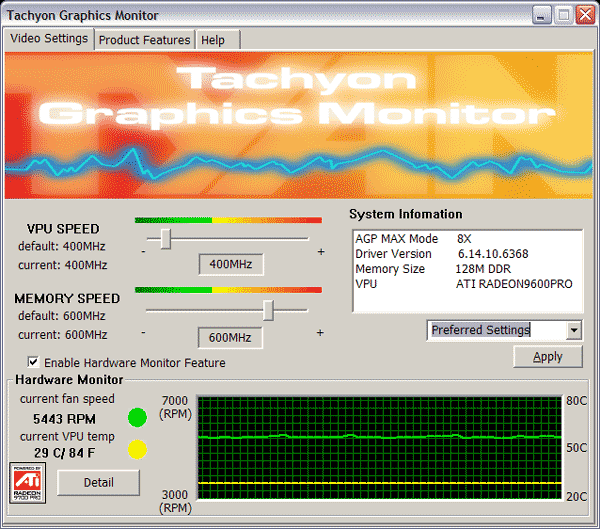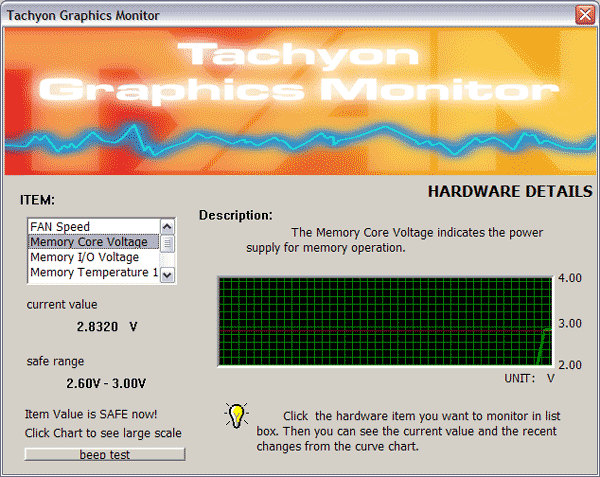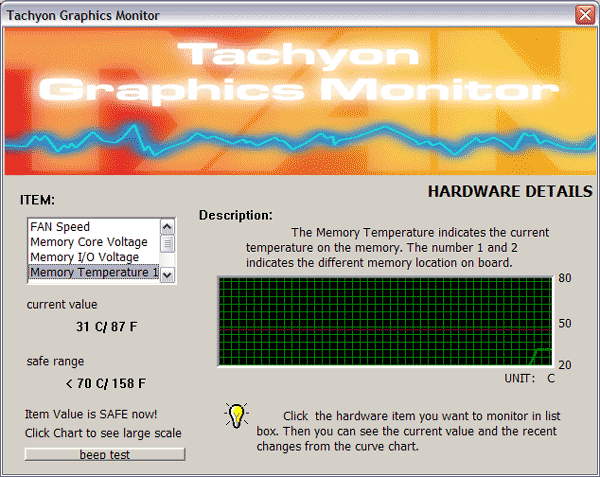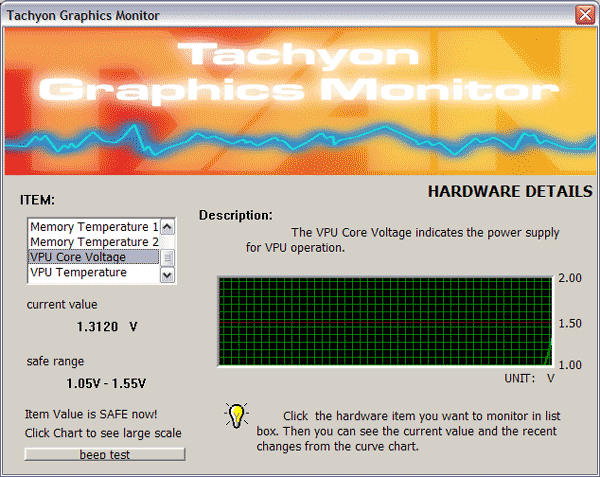TYAN Tachyon G9600 PRO 128MB (ATI RADEON 9600 PRO) Video Card Review
|

CONTENTS
-
Video card features
-
Testbed, test tools, 2D quality
-
Test results: performance diagrams
-
Conclusion
Have you ever thought about how electrons work inside a graphics processor?
How do pipelines operate and texture processors apply textures?
It makes an amusing picture if we represent a GPU in the form of a galaxy.
An electron will be right the size of a man :-). Imagine there are 4 big
constellations, - they are pipelines. And so on. Now let's imagine that
a man goes at the speed of 5 km/h, the Earth makes one rotation every 24
hours, and if a man stands on the equator he covers 40 000 km in addition,
i.e. about 1666 km/h, or 462 m/s. The yearly distance comes to 40000*365=14600000
km. Not bad, right? I don't remember diameters of the ellipse of the trajectory
of the Earth's revolution around the Sun, but if we take that the orbit
is round with the radius of 150M km, the Earth will cover 942M km a year
(2*pi*r) at the speed of 107534 km/h, or 30 km/s. If we add it to the distance
covering simply because of the Earth rotation, we will get astronomic figures...
But it's still too slow compared to the tachyon speed, a hypothetic
particle having a superlight speed. If a man is an electron, and the above
speeds ensure an acceptable speed for a GPU, what will we get with a tachyon-based
GPU?
So, today we have a tachyon. And it's made by TYAN. Will the video card
fly at the superlight speed if we throw it off from the window? :-) It
will simply break through the Earth, pass the core, fly out from the other
side, and reach the Sun in 5 minutes. I wonder if the warranty will be
still in force after that :)
Unfortunately, the truth is not always so bright and tempting as marketing
names. The RADEON 9600 PRO has little in common with tachyons. Unfortunately,
TYAN tied this name with all video cards, including RADEON 9000 :-). Well,
it's all just a joke, let's get back on track. Have a look at the reviews
devoted to the R300/R350/RV250/RV350.
Theoretical materials and reviews of video cards which concern functional
properties of the GPU ATI RADEON 9500/9700/9800
- Analysis of RADEON 9700 architecture
and Microsoft DirectX 9.0
- ATI RADEON 9700 Pro 128MB Review
- Gigabyte MAYA II R9700Pro 128MB
- performance estimated on the new Pentium 4 2.53 GHz based platform, comparison
with the NVIDIA's 40.41 driver
- Hercules 3D Prophet 9700
Pro 128MB - new CATALYST 2.3 driver estimated in 3DMark2001 SE, and Unreal
Tournament 2003 DEMO final release
- PowerColor Evil Commando2 RADEON 9700 Pro 128MB - performance
of the new CATALYST 2.3 driver estimated in game tests, 3D quality issues
- Hercules 3D Prophet 9700 Pro
on ATI RADEON 9700 Pro: extreme overclocking
- ATI RADEON 9500, 9700 and Gigabyte
MAYA II RADEON 9500
- Sapphire Atlantis RADEON
9500 128MB and videocards tests in DOOM III v.0.02
- ATI RADEON 9500 PRO 128MB
- Gigabyte MAYA II RADEON
9500 PRO and Hercules 3D Prophet 9500 PRO - detailed analysis of anisotropic
filtering of RADEON 9700
- Sapphire Technology RADEON
7500, 8500, 9000/Pro, 9700 Pro, anisotropic filtering of RADEON 9700
- HIS Excalibur RADEON 9700 PRO
- Tests in DirectX 9.0 RC0
- ATI RADEON 9500 64MB,
9500 128MB, 9500 PRO, 9700 and 9700 PRO in DirectX 9.0: Part 1 - Game tests in
3DMark2001, and Soft9700!
- ATI RADEON 9500 64MB,
9500 128MB, 9500 PRO, 9700 and 9700 PRO in DirectX 9.0: Part 2 - Tests in DirectX
9.0 - synthetic tests from RightMark 3D
- Sapphire Atlantis
RADEON 9700 and RADEON 9700 PRO Ultimate Edition
- YUAN SmartVGA RADEON 9000 64MB
and RADEON 9700 PRO
- Connect3D video cards
on the ATI's chips
- ATI RADEON 9800 PRO 128MB
- ATI RADEON 9600 PRO 128MB: Part 1 - game tests and
performance
- Hercules 3D Prophet 9800 PRO 128MB and Hercules
3D Prophet 7500 128MB, and scandal around the 3DMark03
- Hercules 3D Prophet 9800 PRO 128MB and Hercules
3D Prophet 7500 128MB (single page)
- Sapphire Technologies ATI RADEON 9200/9600/9600PRO/9800PRO
video cards
- Connect3D, Gigabyte and CP.Technology ATI RADEON
9800 PRO video cards
- Sapphire Atlantis RADEON 9600 256MB, Sapphire Atlantis
RADEON 9600 PRO Ultimate Edition 128MB, Gigabyte RADEON 9600 PRO 128MB, Hercules
3D Prophet 9600 PRO 128MB
- Manli RADEON 9800 PRO 256MB on ATI RADEON 9800
PRO
- ATI RADEON 9600/9600 PRO based cards from Gigabyte,
Hercules and Sapphire
- Sapphire Atlantis RADEON 9800 PRO 256MB Ultimate
Edition on ATI RADEON 9800 PRO - graphics quality in UT2003/Unreal II and
other games, tricks with anisotropy
We know that the RADEON 9600 PRO based card is positioned on the upper
middle-end market and competes against the NVIDIA GeForce FX 5600 Ultra.
It makes no sense to compare it with the previous generations RADEON 9500/PRO
because such cards leave the market pretty fast.
This card is a unique solution from TYAN. It has a design different
from the reference one.
By the way, the company itself was founded in 1989 by one of then directors
of Intel and IBM, and he keeps on running it. The company makes mostly
expensive mainboards for the market of servers and workstations, as well
as servers and workstations themselves.
Some time ago the firm started expanding its activity and now makes
mainboards for home and office PCs as well. Video cards have also entered
its range of products, and all of them got the trademark Tachyon.
Card
AGP x8/x4/x2 interface, 128 MB DDR SDRAM memory in 8 chips on
both PCB sides.
|
| TYAN Tachyon G9600 PRO 128MB |
| Hynix memory chips of 3.6ns access time, it corresponds to 275
(550) MHz, but the memory works at 300 (600) MHz (it's overclocking!).
The GPU runs at 400 MHz. 128bit memory interface. |

|
| Comparison with the reference design, front view |
| TYAN Tachyon G9600 PRO 128MB |
Reference card ATI RADEON 9600 PRO |

|

|

|
| Comparison with the reference design, back view |
| TYAN Tachyon G9600 PRO 128MB |
Reference card ATI RADEON 9600 PRO |

|

|

|
|
The PCB design, as you can see, is strongly different from the reference card.
There's space for the RAGE THEATER 200 chip which probably provides the VIVO support.
Secondly, there is a card hardware monitoring system which will be described a
bit later.
And now comes the cooler.
| TYAN Tachyon G9600 PRO 128MB |
| The cooler consists of two heatsinks, one of them,
which is installed in front, has a very speedy fan (up to 5500 rpm). Both heatsinks
cool down both GPU and memory chips. They are pressed to the memory with resilient
thermoelements placed between the sink and chip surface. |

|

|
And this is the unique hardware monitoring technology.

Temperature control is on the shoulders of the Winbond's chip. The TYAN Graphic
Monitor program is in charge of the monitoring:








As you can see, it controls voltage on the core and memory, temperature of
the core (probably by the CPU means), on the upper memory unit and on the right
unit (each unit has one thermistor). The fan has a tachometer and its rotational
speed is therefore controlled as well.
The PCB has a speaker in the upper right-hand corner which will warn in case
of any deviations of the parameters. The TGM program hangs in the task bar below
on the right. Also note that the utility has an overclocker.
Finally, here is the GPU itself (it consumes only 1.3V):

Let's see what the box contains.
|
| TYAN Tachyon G9600 PRO 128MB |
| CD with system software (including TGM and WinDVD), user manuals, S-Video-to-RCA
and DVI-to-d-Sub adapters, TV-out extenders. |

|
| TYAN Tachyon G9600 PRO 128MB |
| The box demonstrates the card's clock speeds twice (usually
card makers don't indicate them at all). |

|

|
Testbed and drivers
Testbed:
-
Pentium 4 3200 MHz based computer:
-
Intel Pentium 4 3200 MHz CPU;
-
DFI LANParty Pro875 (i875P) mainboard;
-
1024 MB DDR SDRAM;
-
Seagate Barracuda IV 40GB HDD;
-
Windows XP SP1; DirectX 9.0a;
-
ViewSonic P810 (21") and ViewSonic P817 (21")
monitors.
-
ATI drivers v6.368.
VSync off, S3TC off in applications.
Overclocking
|
| TYAN Tachyon G9600 PRO 128MB |
400/600 -> 480/604 MHz (it makes no sense to overclock the card
as the memory clock is already lifted by the manufacturer! And the card's performance
is limited primarily by the memory) |
Note that:
-
during the overclocking you should provide additional cooling, in particular,
for the card (first of all, for its memory):

-
overclocking depends on a sample, and you shouldn't generalize the results
of one card to all video cards of this trade mark or series. The overclocking
results are not the obligatory characteristics of video cards.
Test results
Before we start examining 2D quality, I should say there are no complete
techniques for objective 2D quality estimation because:
-
2D quality much depends on certain samples for almost all modern 3D accelerators;
-
Besides videocards, 2D quality depends on monitors and cables;
-
Moreover, certain monitors might not work properly with certain video cards.
With the ViewSonic P817 monitor and BNC Bargo cable the card showed excellent
quality at the following resolutions and clock speeds:
|
| TYAN Tachyon G9600 PRO 128MB |
1600x1200x85Hz, 1280x1024x100Hz, 1024x768x100Hz |
Test results: cards' performance
Test applications:
-
Return to Castle Wolfenstein (MultiPlayer) (id Software/Activision) - OpenGL,
multitexturing, ixbt0703-demo, test settings - maximum, S3TC OFF,
the configurations can be downloaded from here
Test order: press '~' to invoke the console then type:
timedemo 1 (press Enter)
demo [file name] (press Enter)
-
Unreal 2: The Awakening (Infogrames), DirectX 8.1, multitexturing, tested
with the additional packet Bench'emAll!
2.5beta.
-
Serious Sam: The Second Encounter v.1.05 (Croteam/GodGames) - OpenGL, multitexturing,
ixbt0703demo, test settings: quality.
Test order: press '~' to invoke the console then type:
dem_bProfile=1 (press Enter)
start the demo from the menu
-
Codecreatures Benchmark Pro (Codecult) - Direct3D, Shaders, Hardware T&L,
Dot3, cube texturing, high quality
Test order:
Codecreatures Benchmark Pro.exe (press Enter) Select a required
test in the menu, or run the tests (in the Official Benchmark submenu)
starting from 1600x1200 up to 1024x768.
-
Unreal Tournament 2003 v.2225 (Digital Extreme/Epic Games) - Direct3D,
Vertex Shaders, Hardware T&L, Dot3, cube texturing, default quality
ixbt0703demo test scene.
-
RightMark 3D (one of
the game scenes) - DirectX 8.1, Dot3, cube texturing, shadow buffers, vertex
and pixel shaders (1.1, 1.4).
test settings: pixel shaders 1.1, shadow buffers OFF.
Performance
-
1. Return to Castle Wolfenstein -
-
2. Unreal Tournament 2003 -
-
3. Codecreatures Benchmark Pro
-
4. Unreal 2: The Awakening
-
5. Serious Sam: The Second Encounter
-
6. RightMark 3D
It's useless to repeat that the RADEON 9600 PRO is a strong competitor
against the NVIDIA GeForce FX 5600 Ultra. The today's card proves this
fact again as its performance is not worse than that of the earlier tested
RADEON 9600 PRO based cards.
Conclusion
So, the TYAN Tachyon G9600 PRO 128MB can offer you:
-
Good speed in 3D graphics which makes possible to play with AA and/or anisotropic
filtering;
-
Modern technological solution with the DX9 support;
-
Control over temperatures and voltages. It's especially precious when a
user undertakes overclocking. However, with such memory chips overclocking
is hardly possible!
I'm surprised that such a respected and powerful company overclocks memory
on video cards. On the other hand, there are few complains about quality
of TYAN's products, this is a famous brand and every sample goes through
careful manual control. Probably, the engineers are firmly convinced that
the PCB layout is reliable and thoroughly test such chips at the increased
frequencies. Of course, voltage is above (2.8V) than normal (2.5V). So it's possible
to use this memory on 300 MHz. But anyway, overclocking will be overclocking. Here's a line
from the specs of this memory:
4Mx32 HY5DU283222F-36 128M 4K 2.5V 275MHz
144 FBGA
Its nominal frequency is 275 MHz. It's not 300 MHz this video card works
at.
In our 3Digest
you can find full comparison characteristics for video cards of this and
other classes.
Write a comment below. No registration needed!
|
|
 |
|
|
|

